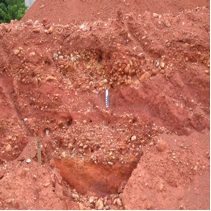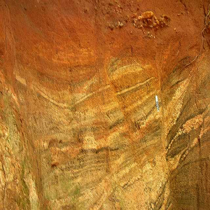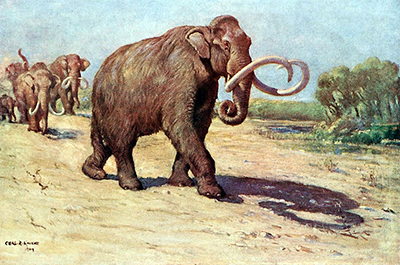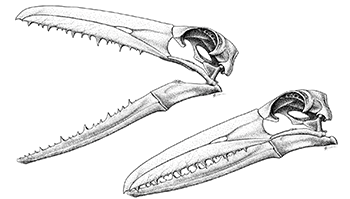Geology and Paleontology of South Carolina
South Carolina Geology
South Carolina rocks and sediments provide a record of geologic history extending back over one billion years! You can learn more about the geologic history of our state by visiting the SC Geological Survey and the The Geology of South Carolina website.
The Geology of Clemson
Even on campus here at Clemson University, few people realize that Clemson’s namesake, Thomas Green Clemson, who is well know for agricultural pursuits in the latter part of his life, studied geology at the Royal School of Mines in Paris, and later worked at mines in the United States as a geologist. Thomas Green Clemson even named a variety of mineral called Seybertite, a specimen of which is on display at the Bob Campbell Geology Museum.
If you're familiar with the upstate of South Carolina, you can't get away from the red clay that forms our topsoil. But what's underneath all this? Well, sometimes stream cuts, road cuts, and construction excavations reveal what is buried under the clay. One construction site on the west side of the city of Clemson, just on the Pickens County side of the Seneca River, reveals an interesting geological cross-section.
While excavating an area behind the foundation of lakefront condominiums, a seven foot thick section of sand, clay, cobbles, and unusual white rock was exposed. What was this material and how did it get there?
 The mixture of sand, clay, pebbles and cobbles is a type of sedimentary material known as conglomerate, which is commonly formed through deposition of detritus (i.e. the sand and pebbles) by streams and rivers. In our case, the conglomerate was deposited by the Seneca River. Over many thousands of years the water flowing through the river channel slowly cut down into the underlying rock. As this happened, the rock was broken down into smaller fragments and carried away (a process called erosion). The rock fragments were further abraded and broken down as they traveled, resulting in the smooth pebbles and cobbles seen in the outcrop. When the river's current wasn't strong enough to carry the load of large rock fragments, they were deposited and formed the river's bed (sedimentation). As water flow slowed down even more, the finer sand grains were deposited.
The mixture of sand, clay, pebbles and cobbles is a type of sedimentary material known as conglomerate, which is commonly formed through deposition of detritus (i.e. the sand and pebbles) by streams and rivers. In our case, the conglomerate was deposited by the Seneca River. Over many thousands of years the water flowing through the river channel slowly cut down into the underlying rock. As this happened, the rock was broken down into smaller fragments and carried away (a process called erosion). The rock fragments were further abraded and broken down as they traveled, resulting in the smooth pebbles and cobbles seen in the outcrop. When the river's current wasn't strong enough to carry the load of large rock fragments, they were deposited and formed the river's bed (sedimentation). As water flow slowed down even more, the finer sand grains were deposited.
 The white material visible in the outcrop is a type of rock known as gneiss (seen in the sample to the left). This rock, which is over one billion years old, formed when igneous rocks located miles below the earth's surface were subjected to very high temperatures and pressure. The gneiss in our outcrop is actually a metamorphosed granite that is composed of feldspar (white), quartz (gray), and mica (black). As the rock was metamorphosed it became folded, and the minerals were aligned in distinctive planes, giving the rock a banded appearance. This is the rock that the Seneca River cut through, and most of the rounded rocks in the conglomerate are gneiss.
The white material visible in the outcrop is a type of rock known as gneiss (seen in the sample to the left). This rock, which is over one billion years old, formed when igneous rocks located miles below the earth's surface were subjected to very high temperatures and pressure. The gneiss in our outcrop is actually a metamorphosed granite that is composed of feldspar (white), quartz (gray), and mica (black). As the rock was metamorphosed it became folded, and the minerals were aligned in distinctive planes, giving the rock a banded appearance. This is the rock that the Seneca River cut through, and most of the rounded rocks in the conglomerate are gneiss.
 At the top of the photo to the right, the ancient river bed can be seen on top of the gneiss. The boundary between these two units is an erosional surface known as a nonconformity. Some interesting observations on the gneiss: Fresh, unweathered rock is very hard and difficult to break with a rock hammer. However, it can become so highly weathered that it will crumble in your hands (at this point the material is called saprolite). The feldspar and mica that form the gneiss slowly break down into microscopic grains, forming the clay so common in the Upstate. The red color is the result of the oxidation ("rusting") of iron locked up in the minerals in the clay. Gneiss is an important rock in the Upstate because it is rather porous, making it easy for groundwater to move through it. Many people still rely on wells drilled into the bedrock for their water supply.
At the top of the photo to the right, the ancient river bed can be seen on top of the gneiss. The boundary between these two units is an erosional surface known as a nonconformity. Some interesting observations on the gneiss: Fresh, unweathered rock is very hard and difficult to break with a rock hammer. However, it can become so highly weathered that it will crumble in your hands (at this point the material is called saprolite). The feldspar and mica that form the gneiss slowly break down into microscopic grains, forming the clay so common in the Upstate. The red color is the result of the oxidation ("rusting") of iron locked up in the minerals in the clay. Gneiss is an important rock in the Upstate because it is rather porous, making it easy for groundwater to move through it. Many people still rely on wells drilled into the bedrock for their water supply.
Paleontological Resources of South Carolina
South Carolina holds a singular place in the history of paleontology in the United States. The first vertebrate fossils recorded from North America, were found in South Carolina. The teeth of a Columbian Mammoth (Mammuthus columbi) were found in a swamp near Charleston, South Carolina in 1725 by enslaved persons, who immediately recognized the resemblance of the fossils to modern African Elephants. The fossils were formally described by famous naturalist Georges Cuvier in 1806. Appropriately, the Columbian Mammoth was designated as the state fossil of South Carolina in 2014.
Another enigmatic ancient species that South Carolina is known for, is the extinct giant whiteshark, Carcharodon megalodon. The teeth of these enormous marine predators, like the one pictured below (BCGM 10155) are frequently found along the coast of South Carolina. C. megalodon reached lengths of up to 50 feet and the largest teeth are greater than seven inches across.
Did you know that the largest flying bird known to man is from right here in South Carolina? Pelagornis sandersi is a giant seabird that prowled the waters off the coast of South Carolina during the Oligocene Period of Earth History (~27 million years ago). Pelagornis sandersi was part of an extinct lineage of birds called "pseudotoothed birds" because of the bony projections on their beaks that resembled teeth. Pelagornis sandersi had a wingspan of approximately 6.4 meters (i.e., the size of a small plane) and was probably quite adept at gliding.
Come visit the Bob Campbell Geology Museum to learn more about these (and many other) fascinating extinct creatures from South Carolina. We have a permanent display of fossils from localities across the lowcountry, including a unique collection of vertebrate fossils from Edisto Island in Charleston County.
Links to other websites with useful information about geological and paleontological topics
- The South Carolina State Museum
- The North Carolina Museum of Natural Sciences
- The North Carolina Fossil Club
- The Geological Society of America
- Society of Vertebrate Paleontology
- Digimorph Digital Library
- Society of Avian Paleontology and Evolution
- The Fossil Calibration Database
- International Commission on Stratigraphy
- Stratfit.org
- Paleosmith.org
- Paleomap Project
- Geologic Time - Online Exhibit - UC Berkeley
- History of Life - Online Exhibit - UC Berkeley
- The National Evolutionary Synthesis Center
- The National Center for Science Education
- The American Museum of Natural History
- The Field Museum
- The Smithsonian Institution National Museum of Natural History
Images are from creative commons or are photos of BCGM specimens.


